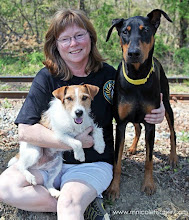
First we did the white numbered sequence which was designed to allow the dog to move in a mostly straight line and then we did the black numbered sequence designed to start to teach the handlers and dogs the differences in handling between running straight ahead and turning. In between doing some of the other sequences we occasionally ran the white numbers to give the dogs an easy sequence to keep them from thinking that every sequence was going to be about turning.
All the handlers did a great job of cuing their dogs by either moving laterally toward #4 as the dog committed to #3 or they used a deceleration cue combined with the dog's name to let their dog know something was different from the previous sequence when they charged down the line to the tunnel.
I love this set up for teaching turning cues because it can be used to alternate between running straight and turning which allows both handler and dog to identify the differences in when they should charge straight ahead and when they should ease of the gas and prepare for a turn.
We also did the mirror image of the black numbered sequence so that both handlers and dogs could practice turning in either direction. Often either the dog or the handler (or both) will have more trouble turning in one direction and it can be really helpful to know which is the "weaker" side so that you can practice a little more on that side.
The next sequence was the one with the white numbers (and its mirror image):

Now the turn is quite different and the cues are different, too. The dog is running much closer to the tunnel for one thing and for another the turn is only about 45 degrees off the dogs straight path. How do you balance needing to turn, being near the tunnel entrance and only needing to bend the line slightly? Well, that takes practice. Every team is different and you need to do these kinds of drills many times with your dog until the moves are automatic and need hardly any thought.
Make sure to balance the sequences when you turn your dog with a sequence where the dog gets to blast straight into the tunnel to keep it fun and to make the handling differences very clear to the dog. When I run fast and hard for the tunnel and give the commands in an excited way, then go as fast as you can. When I decelerate, turn into you a little as we approach the turning jump or move laterally, pay attention and jump round so you can be ready to move in the new direction.
The class was doing so well on all of these (I feel a little like a proud parent when I see how far they've all come in just a few months), we moved on to the last two sequences which were far more challenging due to the wraps and the number of obstacles that the handlers had to remember.
The black numbered sequence came first and didn't pose much of a problem for any of the dogs. the handlers did a great job of showing deceleration between #5 and #6 so the dogs had no trouble wrapping #6 and following the handler over #7 and #8.
Our final sequence was the white numbered one and the handlers all chose to lead out and do a front cross between #3 and #4 followed by another front cross after the tunnel so they could put the dog over #6 and #7, wrapping #7 and then setting a nice line over #8 and then into the tunnel.
I think everyone left feeling like they had a better idea of the differences between how to communicate that a turn was coming and how to tell their dogs to charge ahead at full speed. I thoroughly enjoy teaching this class because everyone in it is so motivated to learn to be a better handler and trainer and that motivates me to be a better teacher.
Thanks, guys!

No comments:
Post a Comment